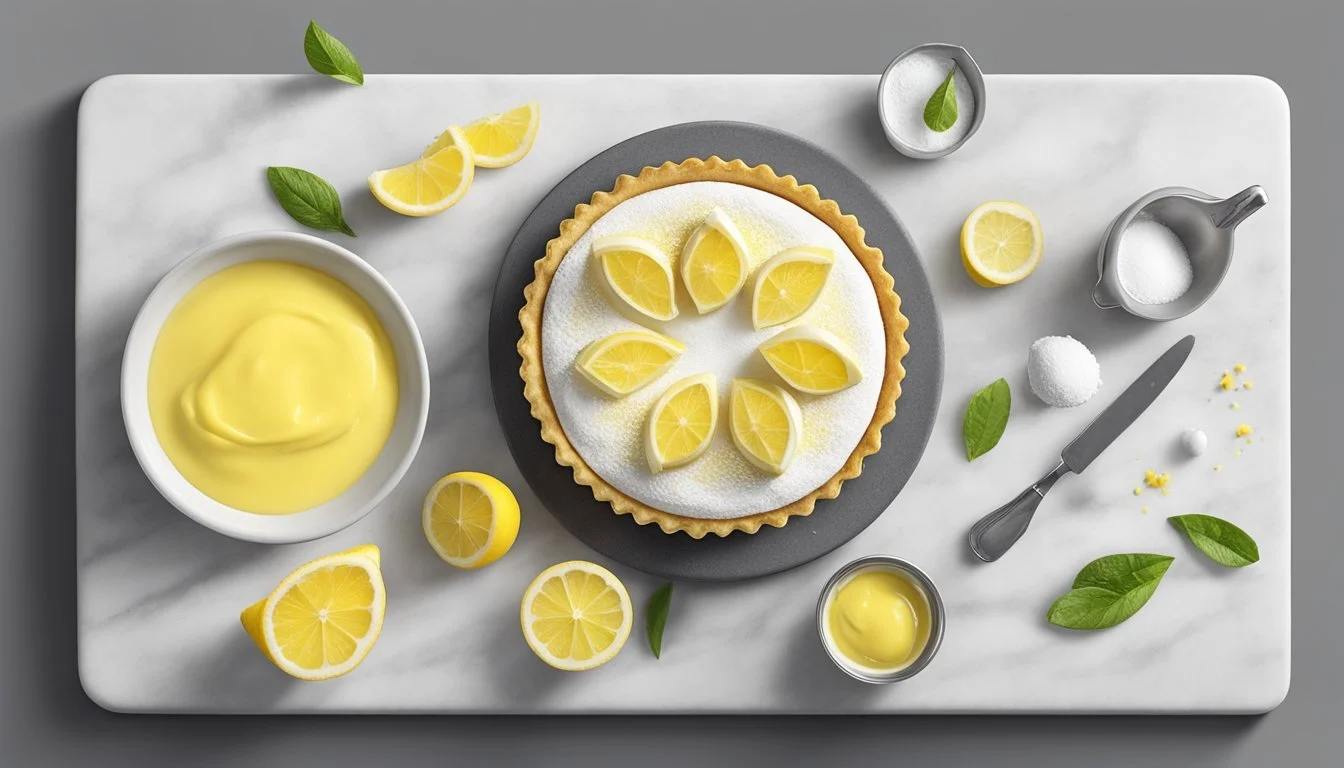How do you eat a lemon tart?
Mastering the Art of Savoring this Citrusy Delicacy
Eating a lemon tart can be a delightful gastronomic experience. This classic dessert, known for its bright, tangy filling and sweet pastry crust, is savored by many for its balance of flavors and textures. The most appropriate way to enjoy a lemon tart involves appreciating its components—the silky lemon curd filling enriched with zest and juice, and the buttery, crisp shell it's cradled in.
With each bite, it's customary to get an even combination of both filling and crust to truly appreciate the contrast and harmony within the tart. It's generally enjoyed chilled, which allows the curd to set properly and the crust to maintain its integrity. For those looking to elevate their experience, a light dusting of powdered sugar just before serving can enhance the tart's aesthetic and flavor profile, providing a slight sweetness that complements the sharpness of the lemon.
Serving size can vary, but typically, a lemon tart is cut into modest wedges, making it an ideal dessert for sharing. An accompaniment such as a dollop of whipped cream or a scoop of vanilla ice cream is often added to balance the tartness with creamy richness. Whether enjoyed on its own or with a topping, the lemon tart presents a refreshing end to any meal.
Selecting Ingredients
When creating a lemon tart, selecting high-quality ingredients is crucial for the final taste and texture of the dessert. Ideal ingredients ensure the lemon tart is flavorful and has the correct balance of tartness and sweetness.
Lemon Selection
Lemon Juice & Zest: Fresh lemons are essential for their juice and zest. Choose lemons that are heavy for their size and have unblemished, brightly colored skins. The zest, which is the outer yellow layer of the peel, adds aromatic oils and intense lemon flavor.
Crust Ingredients
All-Purpose Flour & Butter: The crust, often a pâte sucrée or French tart pastry, requires fine all-purpose flour and high-quality butter. Use unsalted butter, which allows you to control the salt level, and ensure the butter is cold to achieve a flaky crust.
Flour: All-purpose flour is the foundation of the crust.
Unsalted Butter: Provides richness and structure.
Granulated Sugar: Adds sweetness.
Salt: Enhances the overall flavor.
Filling Essentials
Eggs & Sugar: A smooth lemon curd filling is created with a careful balance of eggs and sugar. Eggs should be fresh and ideally at room temperature to blend well. Granulated sugar dissolves evenly for a smooth texture.
Eggs: The base of lemon curd, providing structure and creaminess.
Granulated Sugar: Balances the tartness of the lemon.
Additional Elements
Cream & Butter: Some recipes may call for heavy cream to add richness to the filling. The butter, used in the lemon curd, must be unsalted butter to manage the flavor profile accurately.
Heavy Cream: Optional, for a richer filling.
Unsalted Butter: Gives the lemon curd a silky finish.
Preparation Techniques
A superior lemon tart combines a buttery crust with a tangy, smooth filling, essentially showcasing the balance of textures and flavors. Mastery in preparing both the crust and the filling is essential for creating an unforgettable lemon tart.
Making the Crust
A perfectly prepared crust lays the foundation for a delectable lemon tart. The process begins with shortcrust or shortbread crust, known for their flaky, buttery qualities. Ingredients typically include:
Flour
Butter (ideally at room temperature)
Powdered sugar
A pinch of salt
Ice water (as needed)
One should combine flour and powdered sugar before cutting in the butter. Blend until the mixture resembles coarse crumbs, then add ice water sparingly, just enough to bring the dough together. Form the dough into a disk, wrap it in plastic wrap, and chill before rolling.
A tart pan is then lined with the rolled-out dough, and pie weights or dried beans are used on top of a layer of parchment to blind bake the crust. This prevents the crust from puffing up and helps achieve an evenly cooked base.
Creating the Filling
The lemon filling, with its rich, citrusy flavor, calls for meticulous attention. A common method includes using a double boiler, or a medium saucepan with simmering water, to gently cook the mixture. Ingredients for the filling generally include:
Egg yolks (and sometimes whole eggs)
Sugar
Fresh lemon juice and zest
Cornstarch (for thickening)
Butter
Eggs, sugar, and lemon are whisked together, then cornstarch is added to ensure proper thickening. The cook should stir constantly with a rubber spatula to prevent scorching and to achieve a smooth consistency. Once thickened, pieces of room-temperature butter are incorporated to enrich the mixture.
The warm filling is then poured into the pre-baked tart crust. Smoothing with an offset spatula will guarantee an even layer. The tart is then baked until the filling sets and is subsequently allowed to cool, solidifying into a silky, vibrant lemon layer ready to be savored.
Baking and Assembly
The success of a lemon tart hinges on two critical phases: preparing a properly blind-baked crust and the careful addition of the aromatic lemon filling. Both steps are integral to achieving a tart with a crisp base and a smooth, citrusy custard.
Blind Baking the Crust
One begins the journey to a perfect lemon tart with the crust. The crust, often a pâte sablée resembling shortbread in texture, should be rolled out and placed into the tart tin. Blind baking is then employed to ensure it becomes firm and golden. This process involves lining the unbaked crust with parchment paper and filling it with baking weights or dried beans. The tart shell typically goes into an oven preheated to 180°C (350°F) and bakes until it’s set and edges are golden. The weights prevent the dough from puffing up, ensuring a flat surface for the lemon filling.
Adding the Lemon Filling
After the crust has been blind baked and cooled slightly, it is time to add the lemon filling. The filling, a vibrant mixture of eggs, sugar, lemon zest, and fresh lemon juice, is whisked until smooth. For a richer custard, heavy cream can be included. This mixture is then poured into the crust. The tart returns to the oven, which is now typically lowered to a moderate temperature to gently cook the filling until it's just set but still has a slight wobble in the center.
Final Touches
Post-baking, it's crucial to allow the tart to cool before refrigerating, which helps set the filling completely. Refrigerating for several hours guarantees that the flavors meld and the tart is fully firmed up. When it's thoroughly chilled, one might add a dusting of powdered sugar for a touch of sweetness and a professional finish. If desired, the tart can be adorned with lightly whipped cream or fresh berries upon serving.
Serving Suggestions
When serving a lemon tart, the goal is to complement the tangy flavor of the dessert and enhance its presentation. Each accompaniment should be chosen so that it balances the tartness and adds a textural contrast, while the presentation should highlight the tart's visual appeal.
Accompaniments
Whipped Cream: A dollop of lightly sweetened whipped cream on top of the lemon tart serves to balance its tanginess while adding a creamy texture.
Fresh Berries: Adding a mixture of fresh berries, such as raspberries or blueberries, provides a fruity burst that complements the lemon flavor.
Mint Leaves: A few mint leaves can be used as a garnish, not only to add color but also a refreshing note.
Ice Cream: A scoop of vanilla ice cream beside a warm slice of lemon tart creates a classic flavor combination.
Presentation
Lemon Slices: Thin lemon slices arranged atop the tart lend a professional touch and reinforce the central flavor of the dessert.
Dusting of Powdered Sugar: A light dusting can enhance the sweetness and appearance, ensuring the tart looks as good as it tastes.
Raspberry Coulis: A drizzle of raspberry coulis around the plate introduces a vibrant color and an additional layer of taste.
Mint Sprig: A sprig of mint is not just greenery; it suggests freshness and complements the tart's flavor profile.
Storage and Preservation
When it comes to lemon tarts, ensuring proper storage is critical for maintaining their flavor and texture. The reader will learn about optimized short-term storage techniques as well as methods for long-term preservation, emphasizing the use of refrigeration and wrapping materials.
Short-Term Storage
For short-term storage, lemon tarts should be kept in the refrigerator. After the tart has cooled completely, it needs to be wrapped tightly with plastic wrap to prevent it from absorbing other odors and to maintain moisture. When stored properly, a lemon tart can remain fresh for up to 5 days. One should ensure that their refrigerator's temperature is set between 34°F and 40°F, which is ideal for preventing bacterial growth and spoilage.
Long-Term Preservation
For long-term preservation, there are two main approaches: freezing and converting the tart into a different form, such as a lemon curd to be used later. If freezing, one should first wrap the tart thoroughly in plastic wrap, followed by a layer of aluminum foil to protect against freezer burn. Properly stored in the freezer, a lemon tart can be preserved for several months. However, the texture might be slightly compromised upon thawing, so this method is best used if the tart will be reheated before serving.
Nutritional Information
When indulging in a lemon tart, one is consuming a dessert that is rich in both flavor and calories. A standard serving size, which may vary, typically contains a substantial number of calories, primarily due to the sugar and fat content.
Calories and Fat:
Calories: A serving of lemon tart is estimated to have nearly 500 calories.
Total Fat: On average, a lemon tart could have about 20.8 grams of fat.
The percentage of calories from fat can constitute a significant portion, roughly 37.6% of the total calorie content.
Carbohydrates and Sugars:
Total Carbohydrates: A single portion may deliver close to 78 grams of carbohydrates.
Sugars: Sugar content tends to be high, typically around 51 grams per serving.
It should be noted that the sugar in a lemon tart contributes directly to the calorie density of the dessert.
Other Nutrients:
Protein: Lemon tarts generally offer a modest amount of protein, averaging 6.3 grams.
Dietary Fiber: Fiber content is usually around 1.1 grams per serving.
Cholesterol and Sodium: Tarts can also contain cholesterol, with an average of 116 mg, and a moderate amount of sodium.
The nutritional content can vary significantly based on the recipe and the size of the tart. Those counting calories or monitoring macronutrient intake should consider these factors when consuming lemon tart as part of their diet. As with any dessert, moderation is key, and it is advisable to enjoy lemon tarts as an occasional treat within a balanced diet.
Pairing and Variations
Selecting the perfect accompaniments and exploring different variations can enhance the lemon tart experience. This section will focus on pairing the tart with drinks and side dishes, as well as providing ideas for dessert variations.
Drinks and Side Dishes
When it comes to drinks, a lemon tart pairs beautifully with a range of options:
Tea: A calming chamomile or a brisk Earl Grey complement the tart's citrus notes.
Coffee: Choose a medium roast to balance the tart's sweetness.
Wine: A sweet Riesling or a bubbly Prosecco can enhance the lemon flavor.
As for side dishes, one might consider:
Fresh berries or a berry compote to add a fruity contrast.
Whipped cream or crème fraîche to add richness.
A light dusting of powdered sugar for added sweetness.
Dessert Variations
Lemon tart can be varied in several delicious ways:
Lemon Poppy Seed Muffins: Incorporate lemon zest into muffin batter for a portable treat.
Lemon Bars: For a handheld alternative, use a similar custard atop a shortbread base.
Lemon Pie: Replace pâte sucrée with a flaky pie crust for a more home-style dessert.
French Tart: Use classic French tart recipes as a guide for a custard filled with smooth lemon custard.
Experimenting with these variations can suit different preferences and occasions, each offering a distinct take on the refreshing zing of lemon.
Advanced Tips and Techniques
Making a lemon tart that rivals those found in the best pâtisseries requires precision, patience, and practice. It's not merely about following a recipe but understanding the intricacies that elevate a simple dessert into a culinary masterpiece.
Mastering the Perfect Tart
To achieve the classic French lemon tart, or tarte au citron, one must focus on both flavor and form. Firstly, the shortcrust pastry should be tender and crisp. This is best achieved by keeping all ingredients cold, handling the dough as little as possible, and allowing it to chill thoroughly before rolling and baking. For the filling, a balance of tartness and sweetness is crucial, as well as achieving the silken texture that sets it apart from denser desserts (What wine goes well with desserts?) like crème brûlée.
Flavor: The intensity of the lemon should be front and center. Using fresh lemon juice and zest will provide a bright, citrusy zing.
Form: The tart should have a smooth, shiny surface, free from bubbles or cracks. Pouring the lemon filling through a fine mesh sieve before baking can help achieve this perfection.
Troubleshooting Common Problems
Even experienced bakers can encounter issues when crafting the perfect lemon tart. Common problems include a soggy bottom, or the lemon filling either being too thin or not setting properly.
A soggy bottom on the pastry can often be prevented by blind baking, ensuring that the crust becomes crispy before adding the filling.
If the filling is too runny, it may need more time in the oven, or the proportion of thickening ingredients like eggs or cornstarch needs to be adjusted.
When the filling doesn't set, it's often due to undercooking or an incorrect ratio of liquid to eggs. The filling should be cooked until it reaches the consistency of soft-set jelly and then allowed to cool to set firmly.
By adhering to these advanced tips and techniques, one can successfully navigate potential pitfalls and achieve a tart that is as aesthetically pleasing as it is delicious.
History and Origin
The lemon tart, a dessert celebrated for its vibrant flavor, is a classic French tart with a rich historic tapestry. It not only signifies culinary artistry but also bears witness to the evolution of pastry craft.
Cultural Significance
The lemon tart, or tarte au citron, is ingrained in French culinary tradition. It's a dessert that marries simplicity with elegance, featuring a crisp pastry shell and a smooth, citrusy filling. This dessert's prominence in French cuisine symbolizes a broader appreciation for tarts within European gastronomy. Lemon tarts are often associated with sophistication and are a staple in French pâtisseries and cafes.
Evolution of the Lemon Tart
The lemon tart's journey is marked by subtle variations and refinements. Originally, the filling was a lemon custard, a blend of eggs, sugar, lemon juice, and cream, baked until set. Over time, chefs have modified the recipe, balancing tartness and sweetness to perfection. The modern version may involve a sablé breton crust and a creamy citrus curd, sometimes topped with a light meringue or dusted with icing sugar. This dessert's development reflects broader trends in the pastry world, where innovation and tradition often merge to create something timeless.










